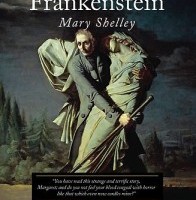Frankenstein: Prometheus Mythic & Modern, by Sean Fitzpatrick
The womb and the tomb—one of the most striking mirror images that our lives have to offer. Babies are buried alive in their warm mothers’ girth. Bodies are dead and buried in their cold mother earth. For one, there is the darkness of genesis and growth, for the other, the darkness of death and decay. The former are born to live for a span; the latter will be reborn to live for an eternity.
This pregnant parallel has been given immortal imagery in Mary Shelley’s Frankenstein; or, The Modern Prometheus. The mythic Prometheus is famous for creating men. The modern Prometheus is infamous for creating monsters. Both are tormented as a result of their creations, punished for the prideful usurping of a creative power that ultimately renders their creation deficient. The mythic Prometheus suffers for defying the supernatural, the modern Prometheus for defying the natural.
On what wings dare he aspire? What the hand, dare seize the fire?William Blake’s poem, “The Tyger,” instigates a dark literary trend of creature questioning and creator cursing, whose questions and curses are echoed by Milton’s Adam, and again by Shelley’s demon. For all of its modern connotations, however, Frankenstein represents an old story of creature rebellion. These rebellions had their birth with Lucifer’s “Non serviam,” and continue to rage with every fit of fallen nature and every man-made object that enslaves man. Victor Frankenstein is both rebel and victim of rebellion, as he turns his back on the order of things, forging into territory reserved for gods, only to be beset by the monstrous offspring of his sin. And as a monster, the creature is very much made in the image and likeness of his creator.
The story of Frankenstein is the quintessential mad scientist story, given immortal voice by Colin Clive in the 1931 film with his unforgettable, “It’s alive!” The story is, without doubt, alive—infused with life by the prevalent failure to recognize and respect the world’s sacrosanct and secret powers. Frankenstein and his monster stand as truly horrifying cultural icons of an enlightened era devoted more to science than to art. It has been said that the opposite of art is science. Art has everything to do with emotion, inspiration, and sacred mysteries. Science has nothing to do with any of these things, dealing instead with comprehension, investigation, and material calculations. As art can perfect nature, so science can pervert nature.
Read the complete article in The Imaginative Conservative
